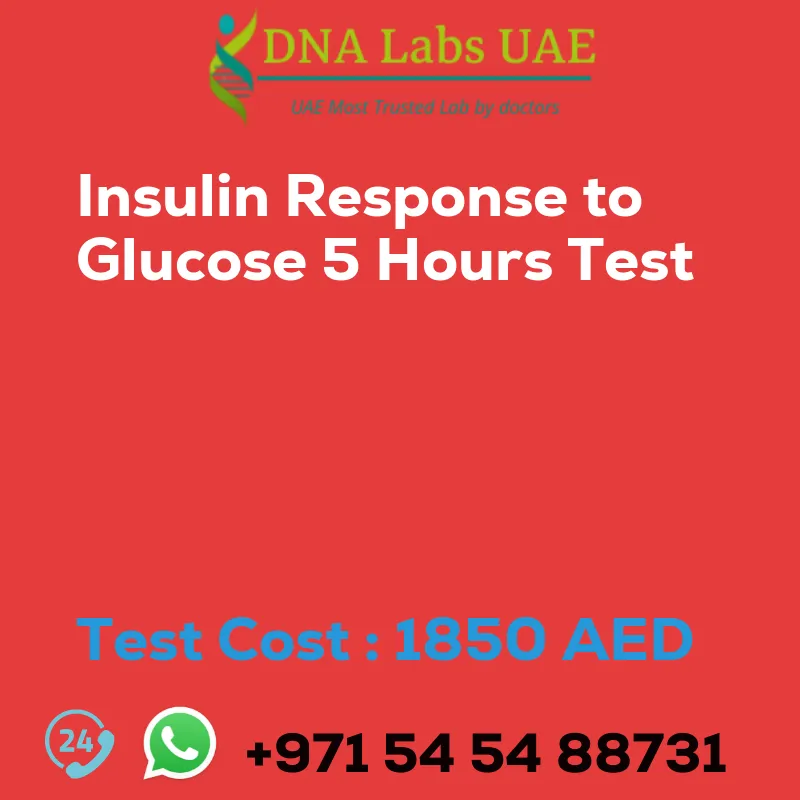INSULIN RESPONSE TO GLUCOSE 5 HOURS Test
Test Cost: AED 1850.0
Test Components:
- 2 mL (1 mL min.) plasma from 1 Grey Top (Sodium Fluoride) tube
- 2 mL (1 mL min.) corresponding serum from 1 SST for each timed specimen set
Sample Condition: Draw baseline fasting specimens. Dissolve 82.5 g glucose monohydrate (equivalent to 75 g anhydrous glucose) in adults or 1.92 g / Kg body wt in children in 300 mL water. Administer orally over a period of 5 minutes. Draw additional samples at 0.5, 1.0, 1.5, 2.0, 2.5, 3.0, 4.0, and 5.0 hours. Note time drawn and tests required on each container label and test request form. Overnight fasting is mandatory. Ship refrigerated or frozen. Urine specimens NOT REQUIRED.
Report Delivery: Daily
Method: Chemiluminescent Microparticle Immunoassay, Hexokinase
Test Type: Diabetes
Doctor: Diabetologist, Physician
Test Department:
Pre Test Information: Overnight fasting is mandatory.
Test Details
The insulin response to glucose can vary depending on various factors such as individual metabolism, insulin sensitivity, and overall health. However, in general, after consuming glucose, the body typically responds by releasing insulin to help regulate blood sugar levels.
Within the first few minutes after glucose consumption, the body begins to release insulin from the beta cells of the pancreas. This initial insulin release helps to quickly transport glucose from the bloodstream into the cells, where it can be used for energy or stored for later use.
Around 30 minutes to 1 hour after glucose consumption, insulin levels peak, signaling that the body has effectively taken up glucose from the bloodstream. This peak in insulin levels helps to prevent blood sugar levels from rising too high.
After the peak, insulin levels gradually decrease but remain elevated for several hours to ensure that glucose is efficiently utilized by the body’s cells. This sustained insulin response helps to maintain stable blood sugar levels and prevent excessive glucose accumulation in the bloodstream.
Overall, the insulin response to glucose is a dynamic process that aims to regulate blood sugar levels and ensure that glucose is properly utilized by the body.
| Test Name | INSULIN RESPONSE TO GLUCOSE 5 HOURS Test |
|---|---|
| Components | |
| Price | 1850.0 AED |
| Sample Condition | 2 mL (1 mL min.) plasma from 1 Grey Top (Sodium Fluoride) tubeAND2 mL (1 mL min.) corresponding serum from 1 SST for each timed specimen set. Draw baseline fasting specimens. Dissolve 82.5 g glucose monohydrate (equivalent to 75 g anhydrous glucose) in adultsor 1.92 g \/ Kg body wt in children in 300 mL water. Administer orally over a period of 5 minutes. Draw additional samples at0.5, 1.0, 1.5, 2.0, 2.5, 3.0, 4.0 and 5.0 hours. Note time drawn andtests required on each container label and test request form. Overnight fasting is mandatory.\nShip refrigerated or frozen. Urine specimens NOTREQUIRED. |
| Report Delivery | Daily |
| Method | Chemiluminescent Microparticle Immunoassay, Hexokinase |
| Test type | Diabetes |
| Doctor | Diabetologist, Physician |
| Test Department: | |
| Pre Test Information | Overnight fasting is mandatory. |
| Test Details |
The insulin response to glucose can vary depending on various factors such as individual metabolism, insulin sensitivity, and overall health. However, in general, after consuming glucose, the body typically responds by releasing insulin to help regulate blood sugar levels. Within the first few minutes after glucose consumption, the body begins to release insulin from the beta cells of the pancreas. This initial insulin release helps to quickly transport glucose from the bloodstream into the cells, where it can be used for energy or stored for later use. Around 30 minutes to 1 hour after glucose consumption, insulin levels peak, signaling that the body has effectively taken up glucose from the bloodstream. This peak in insulin levels helps to prevent blood sugar levels from rising too high. After the peak, insulin levels gradually decrease but remain elevated for several hours to ensure that glucose is efficiently utilized by the body’s cells. This sustained insulin response helps to maintain stable blood sugar levels and prevent excessive glucose accumulation in the bloodstream. Overall, the insulin response to glucose is a dynamic process that aims to regulate blood sugar levels and ensure that glucose is properly utilized by the body. |








